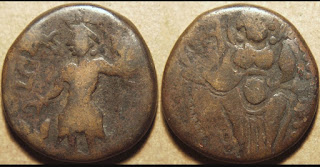Raziyyat-Ud-Dunya Wa Ud-Din, popularly known as Razia Sultana, was a ruler of Delhi Sultanate. She was the first and only female Muslim ruler of Delhi. She ruled from 1236 to 1240 AD. During her rule she proved her mettle as a just and capable ruler, and was renowned for her subversive actions, which varied from sporting men's attire to printing coins in her own name.
Razia Sultan Tanka, silver
In 1205, Razia Sultan was born into the household of Shams-us-din Iltutmish as his only daughter in Badaun. Although he had entered Delhi as a slave worker under Qutb-ud-din Aibak, founder of the Mamluk Dynasty and the first Sultan of Delhi, he had impressed the ruler with his efficiency, and had been appointed as a provincial governor. Aibak married his daughter Qutb Jaan to Iltutmish. Iltutmish sought to impart these same qualities to his children, including Razia and ensured they were all well-educated and trained in archery, martial arts and administration.
On 30 April 1236, Iltutmish passed away, appointing Razia as his rightful heir. The Muslim nobility refused to accept this, and they installed her brother, Ran ud din Firuz, on the throne. His rule, which was managed by Shah Turkaan, Iltutmish's widow, came to an abrupt end a mere 6 months later, when both he and his mother were assassinated. Razia was finally handed over the reign on 10 November 1236.
Razia Sultan, 18th Century, Alamy
Razia ascended the throne as Jalalat ud din Raziya and immediately dropped her veil, replacing it with men's attire. She was proud of her kingdom and conquered new territories. She established schools, academics, and public libraries.
Sultanate Empire, 1236 AD.
The Turkish nobles were displeased by Razia's efficient rule as well as her rumoured involvement with Jamal ud Din Yaqut, an Abyssinnian Siddi slave. Despite her courageous efforts, she was taken into capture, and her brother, Muizuddin Bahram Shah, usurped the throne once Yaqut was murdered.
Malik Altunia, governor of Bhatinda fell in love with Razia's charm and wit and took her as his wife. He rebelled against the Turkish nobles and was determined to win Razia back her kingdom. He planned a siege on behalf of his sovereign. Together they marched towards Delhi in October 1240 AD but were unsuccessful in their conquest against Bahram. Razia and Altunia fled Delhi the next day. With their remaining forces abandoning them, they met their unfortunate end on 15 October 1240 AD when she was 35 years old.
There are many debates about Razia Sultan's burial site. However, it is widely stated that her grave is located at Mohalla Babuli Khana near Turkman Gate in Old Delhi. It was built by her successor and half-brother Bahram. Her sister's (Shazia) grave is located besides her grave.
Razia Sultana Tomb, Delhi, Turkman Gate, Sajia, her sister buried next to her.
Plaque
Coins of Razia Sultan
Bengal Sultanate, AH 634-637, 1236-1240 AD, Tanka, silver, weight 10.3 gm, Lakhnauti mint, struck in her own name.
Bengal Sultanate, AH 634-637, 1236-1240 AD, Tanka, silver, weight 10.4 gm, Lakhnauti mint, Obverse: inscribed as Al-Sultan Al- A'zam Jalalat Al-Dunya Wa'l Din Malikha Ibnat Iltutmish Al- Sultan Nasrat Amir Al- Mu Minnin, Reverse: inscribed as Fi had Al iman Al Mustasim amir Al Muminin.
Delhi Sultanate, Billon, Jital, AH 636-637, 1236-1240 AD, weight 3.5 gm, horseman to the right
Delhi Sultanate, Jital, 1236-1240 AD, Billon, weight 3.6 gm, Obverse: Horseman, legend in Nagari around, lettering Sri Hamira, Reverse: legend in Persia, lettering Jalalat al-Din Radiyya.
Delhi Sultanate, Jital, Billon, 1236-1240 AD, weight 3.5 gm, Horseman right, Four lines Arabic legend, al-sultan al-muázzam radiyyat al-din bint al-sultan
Razia SultanCoins of Razia Sultan












































